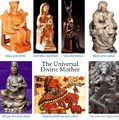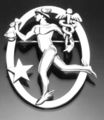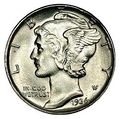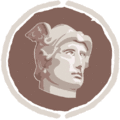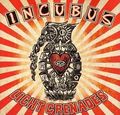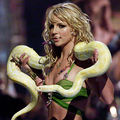911:Occult symbolism VII
Site menu:
- Occult symbolism Intro
- History of oppression
- Social terrorism
- Economic terrorism
- Occult symbolism pages:
- Introduction to symbolism
- Part I (Egyptian mythology, Pyramid, All-seeing eye, Obelisk)
- Part II (Astrology)
- Part III (Stars)
- Part IV (Cross, Rods, Awen, Thunderbolt, Bell, Shell)
- Part V (Occultism)
- Part VI (Circles, Infinity, Spirals)
- Part VII (Deities)
- Part VIII (Colors)
- Part IX (Alphabets)
- Part X (Animals, Insects, Arachnids)
- Part XI (Plants)
- Part XII (Life, Death, Sexuality)
- Part XIII (Alchemy)
- Part XIV (Masonic symbolism)
- Part XV (Masonic places)
- Part XVI (Hand signs)
- Part XVII (Occult Media Programming)
Deities
- Various notes:
Mother goddess
One of the most outstanding examples of how Babylonian paganism has continued to our day may be seen in the way the Romish church invented Mary worship to replace the ancient worship of the mother goddess.
The story of the mother and child was widely known in ancient Babylon and developed into an established worship. Numerous monuments of Babylon show the goddess mother Semiramis with her child Tammuz in her arms. When the people of Babylon were scattered to the various parts of the earth, they carried the worship of the divine mother and her child with them. This explains why many nations worshipped a mother and child in one form or another centuries before the true savior, Jesus Christ, was born into this world! In the various countries where this worship spread, the mother and child were called by different names, for, we will recall, language was confused at Babel.
The Chinese had a mother goddess called Shing Moo or the "Holy Mother." She is pictured with child in arms and rays of glory around her head.
The ancient Germans worshipped the virgin Hertha with child in arms. The Scandinavians called her Disa who was also pictured with a child. The Etruscans called her Nutria, and among the Druids the Virgo-Patitura was worshipped as the "Mother of God." In India, she was known as Indrani, who was also represented with child in arms.
The mother goddess was known as Aphodite or Ceres to the Greeks; Nana, to the Sumerians; and as Venus or Fortuna to her devotees in the olden days of Rome, and her child as Jupiter. At one time the mother and child were known as Devaki and Crishna. For ages, Isi, the "Great Goddess" and her child Iswara, have been worshipped in India where temples were erected for their worship.
In Asia, the mother was known as Cybele and the child as Deoius (Attis?). "But regardless of her name or place", says one writer, "she was the wife of Baal, the virgin queen of heaven, who born fruit although she never conceived." [1]
In Ephesus, the great mother was known as Diana. The temple dedicated to her in that city was one of the seven wonders of the ancient world! Not only at Ephesus, but throughout all Asia and the world was the goddess worshipped (Acts 19:27).
In Egypt, the mother was known as Isis and her child as Horus. It is very common for the religious monuments of Egypt to show the infant Horus seated on the lap of his mother.
This false worship, having spread from Babylon to the various nations, in different names and forms, finally became established at Rome and throughout the Roman Empire. Says a noted writer concerning this period: "The worship of the Great Mother (Queen of Heaven)...was ...very popular under the Roman Empire. Inscriptions prove that the two (the mother and the child) received divine honors ... not only in Italy and especially at Rome (Madonna), but also in the provinces, particularly in Africa, Spain, Portugal, France, Germany, and Bulgaria."
- Various notes:
Universal mother goddess mythology.
Gaia, Demeter, Isis, Maria (Catholicism), Kuan Yin, Chalchiuhtlicue , Parvati (see also: Devi).
Nimrod
(todo)
Baal
(todo)
- "The Worship and the Service of the Baalim": part 1, part 2 part 3.
- Abortion and the Ancient Practice of Child Sacrifice
- Baal in the Bible
- Abortion on demand is the Baal worship of modern times. King Ahab and Queen Jezebel led the Israelites in Baal worship and the sacrifice of children in the Old Testament. Ahaz went so far as to burn "his son as an offering" to Baal/Moloch, as did Manasseh (see 2 Kings 16:3; 21:6). Why would people make such terrible decisions? It was believed that human sacrifice to Baal held the key to prosperity. People desiring to live in selfish prosperity and ease brought their firstborn child to the high priest, where the child would be offered as a burnt offering to the deity. The altar of Baal was in the image of a bull with the head and shoulders of a man. Its arms extended outward and fire belched out from a hole in the chest. The priest of Baal placed the babies on the outstretched arms, where the child would be rolled into the fire. As the child died, the priest and priestess engaged in sexual intercourse, while an orgy occurred among the onlookers. A Baal cemetery unearthed recently contained the remains of more than twenty thousand children. The Greek author Kleitarchos described this practice of sacrificing infants to Baal three hundred years before Christ: "Out of reverence for Kronos [Baal], the Phoenicians, and especially the Carthaginians, whenever they seek to obtain some great favor, vow one of their children, burning it as a sacrifice to the deity, if they are especially eager to gain success. There stands in their midst a bronze statue of Kronos, its hands extended over a bronze brazier, the flames of which engulf the child. When the flames fall on the body, the limbs contract and the open mouth seems almost to be laughing, until the contracted body slips quietly into the brazier."
Tammuz
(todo)
- Ezekiel 8:14
Then he brought me to the door of the gate of the LORD's house which was toward the north; and, behold, there sat women weeping for Tammuz.
Astarte
(todo)
Cybele
(todo)
Saturn
See: Saturn Occult symbolism: Astrology: Saturn
Hermes
- Various notes:
- Hermes is one of the twelve Olympian gods (the "Dodekatheon"), which were the principal gods of the Greek pantheon, residing atop Mount Olympus. Hermes was the god of boundaries and of the travelers who cross them, of shepherds and cowherds, of thieves and road travelers, of orators and wit, of literature and poets, of athletics, of weights and measures, of invention, of general commerce, and of the imagineing of thieves and liars. His symbols include the tortoise (patience/time/wisdom?), the rooster (sun symbolism/primordial intellect), the winged sandals (spiritual/enlightenment), and the caduceus (priesthood magic). The analogous Roman deity is Mercury. [2] (adapted)
- In Etruscan mythology, Turms was the equivalent of Greek Hermes, god of trade and the messenger god between people and gods.
- In Roman mythology, Mercury was a messenger, and a god of trade, profit and commerce, the son of Maia Maiestas and Jupiter. His name is related to the Latin word merx ("merchandise"; compare merchant, commerce, etc.).
- See also:
- Non-logo's:
Mercury Dime (1916–1945)
The head of Hermes / Mercury appeared on the front side of all US dimes during this period.
- Logo's:
Totus Tuus - a medical management company.
Note: Totus Tuss was Pope John Paul II's apostolic motto. It means "totally yours" and expressed his strong Marian devotion.Hannover Messe
(Est. 1947)
This is the world's largest industrial technology fair, held each year in Hannover, Germany.Delta Air Service logo circa 1929
(Now Delta Airlines)Hermes Groep (bus public transport company)
Mercury automobile logo (owned by the Ford Motor Company)
Mars
Venus
- Various notes:
- Alternative names: "Eastern Star", "Morning Star"
"The Birth of Venus" a painting by Sandro Botticelli from around 1482.
Prometheus
- Various notes:
- See also: Prometheus Bound
- This statue depicts Prometheus, a Titan of Greek mythology known for his great intelligence. He has however betrayed the god Zeus by stealing fire and giving it to mankind. He therefore credited to have taught mankind the arts of civilization such as writing, mathematics, agriculture, medicine, and science. Zeus then punished Prometheus for his crime by having him bound to a rock while a great eagle ate his liver every day only to have it grow back to be eaten again the next day.[3]
Prometheus statue at the Rockefeller Center. Behind the statue is an inscription saying: “Prometheus, teacher in every art, brought the fire that hath proved to mortals a means to mighty ends.”
Note: The ring with the 12 signs of the Zodiac
Pan
- Various notes:
- Pan (Greek Πάν, genitive Πανός) is the Greek god of shepherds and flocks, of mountain wilds, hunting and rustic music: paein means to pasture. He has the hindquarters, legs, and horns of a goat, in the same manner as a faun or satyr. He is recognized as the god of fields, groves, and wooded glens; because of this, Pan is connected to fertility and season of spring.
- Pan's ancient Roman equivalent was Faunus, and they were both horned god deities. For this reason he is popular among many Neopagans and occultic groups.
- "It is likely that the demonized images of the incubus and even the horns and cloven hooves of Satan, as depicted in much medieval and post-medieval Christian literature and art, were taken from the images of Pan." [4]
The Death of Pan
Painting by the French painter Nicolas Poussin (1594-1665).
- Pan in popular culture:
Pans Labyrinth, a 2006 Spanish language fantasy film.
Known mason Walt Disney's Peter Pan
Demons
Incubus
- Various notes:
- In Western medieval legend, an incubus (plural incubi) is a demon in male form supposed to lie upon sleepers, especially women, in order to have sexual intercourse with them. It was believed to do this in order to spawn other incubi. The incubus drains energy from the woman on whom it performs sexual intercourse in order to sustain itself,
(1991– 2008, now on hiatus)
Incubus, a Grammy-nominated alternative rock band from Calabasas, California.2007 album Light Grenades, by Incubus
Succubus
- Various notes:
Lilith
- Various notes:
- Alternative names: Lilitu, Lilit
- Mythological female Mesopotamian storm demon associated with wind and was thought to be a bearer of disease, illness, and death.
- First appeared in a class of wind and storm demons or spirits as Lilitu, in Sumer, circa 4000 BC.
(c. 1892)
Lilith, a painting by British writer and painter John Collier.In this live concert, was Britney Spears being portrayed as Lilith?
